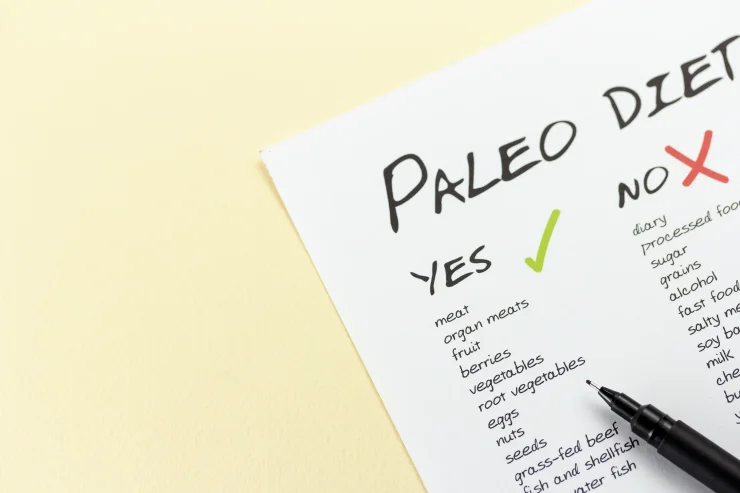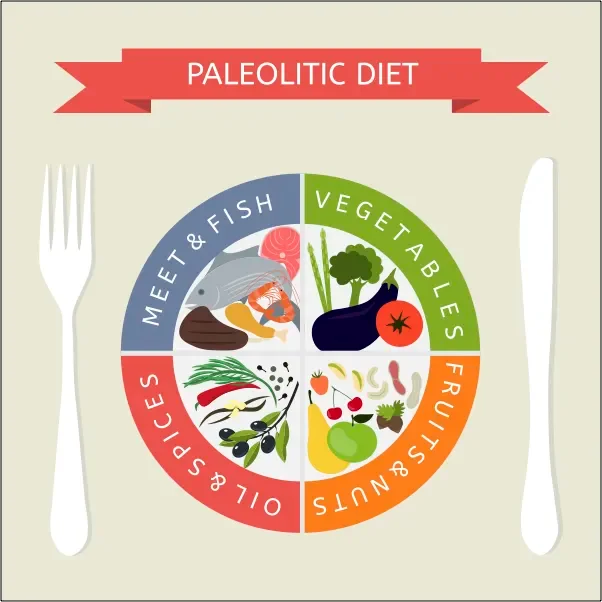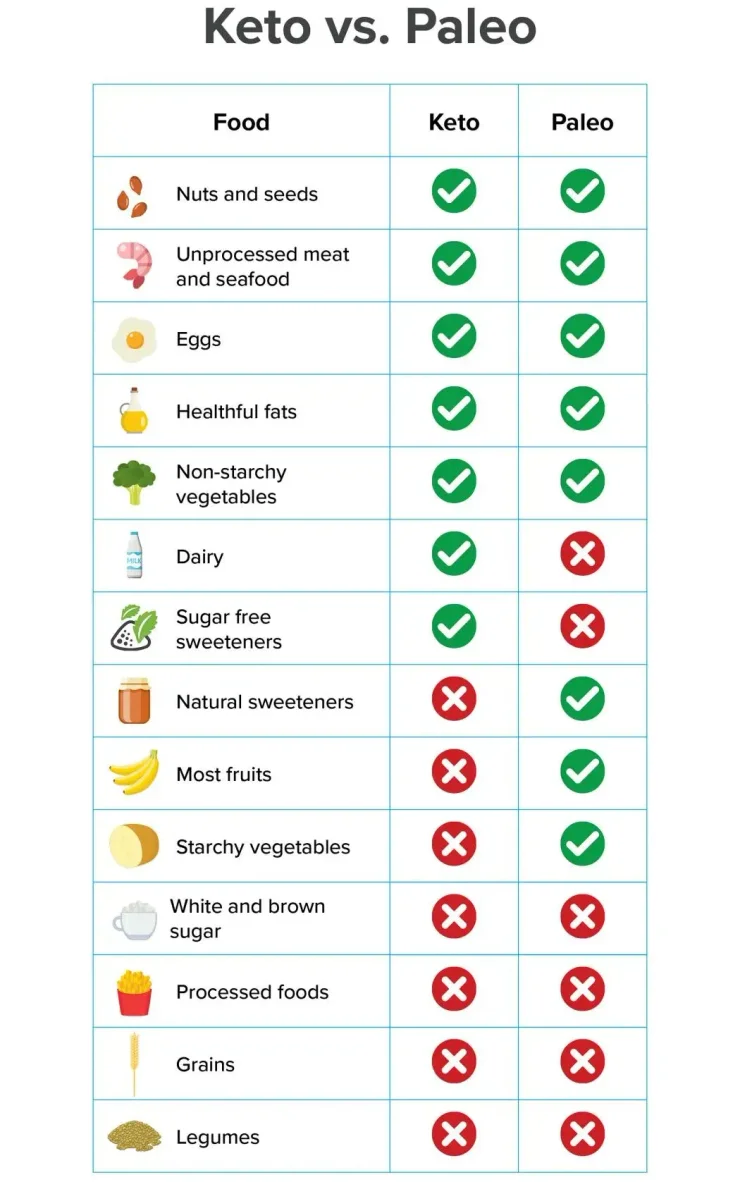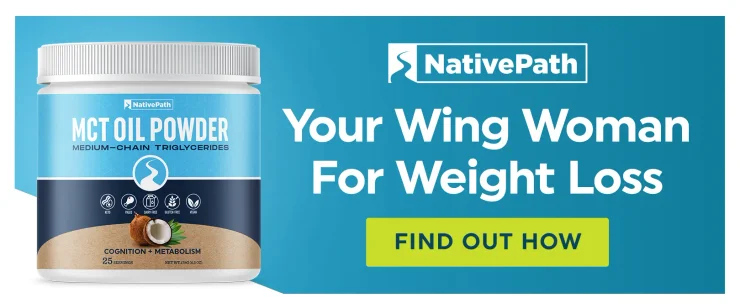Nutrition
The Paleo Diet | A Beginner's Guide + Free Grocery Checklist
November 2, 2021
When debating whether or not to do the paleo diet, a few questions typically arise…
Is this “stone-age” diet worth it?
Do delicious meals even exist on the paleo diet?
Which is better—paleo or keto?
I’m happy you asked. In this article, I’m going to reveal what the paleo diet is, its 6 life-altering benefits, what foods you can and can’t eat, and more.
Table Of Contents
What Is the Paleo Diet?

Often called the “caveman diet” or the “Stone Age Diet”, the paleo diet gets its origins from our Paleolithic ancestors who lived thousands of years ago (1).
These ancestors lived a hunter-gatherer lifestyle—surviving and thriving on a diet consisting of whole, natural foods local to their geographic location.
Think: Grass-fed beef, wild-caught salmon, nutrient-dense vegetables, antioxidant-rich berries, fat-filled nuts.
Several studies have shown that this diet has an array of health benefits ranging from increased energy to weight loss to even a reduced risk of heart disease.
When you take into account our modern-day diet of highly processed, artificial, sugary foods, you can see why the paleo diet became so popular in 2002, and why it’s here to stay (1)...
It aims to replace the foods of the modern world and replace them with foods similar to what our ancestors ate.
6 Benefits of the Paleo Diet
Because the paleo diet is based on modern-day science, there are thousands of studies that support its efficacy in improving overall health, preventing disease, and even reversing the effects of many chronic and deadly diseases.
By removing all processed foods, you are drastically lowering your risk of:
1. Cancer
A study recently published by the BMJ found that people who ate a diet consisting of highly processed food had a 10% increased risk of being diagnosed with breast cancer (2).
2. High Blood Pressure
The high amounts of sodium in processed foods cause an excess of water in your bloodstream and extra strain on the blood vessels leading to your kidneys. This results in higher blood pressure (3).
3. Heart Disease
Research has shown that the paleo diet can increase your IL-10 (a signaling molecule) by 35%.
Lower IL-10 levels have been linked to increased risks of heart attacks and inflammation, whereas high IL-10 levels appear to counteract inflammation (4).
4. Diabetes
Processed food is high in calories but low in fiber, minerals, and vitamins. This causes your body to break down these processed foods too quickly, causing a rapid increase in blood sugar (5).
One small study consisting of 13 individuals with type 2 diabetes resulted in a significant decrease in blood sugar, body fat, diastolic blood pressure, weight, and waist circumference in just three months of following a paleo diet (6).
5. Obesity
Studies have indicated that our brains have a reward system.
Processed foods that contain high levels of sugars, salts, and fats are so rewarding to our brains that food manufacturing companies spend a large number of resources in making their products as addicting as possible, leading to overconsumption and obesity (7, 8).
6. Depression
Many studies have proven that those who eat a diet rich in processed foods are more likely to be diagnosed with depression, whereas those who eat a diet containing large amounts of fruits, vegetables, and fish have lower rates of depression (9).
Foods You Can Eat on the Paleo Diet

The paleo diet focuses on consuming a variety of nutrient-dense foods in their most natural form.
Paleo-approved foods (and helpful guidelines to follow) include:
Meats and Eggs
- Aim for those that are lean, pasture-raised, grass-fed, free of hormones and antibiotics
- Eat wild-caught fish
- Shop at local farmers markets (be sure to ask the farmers what they feed their livestock)
Fruits and Vegetables
- Buy organic
- Avoid pesticides and herbicides
Nuts and Seeds
- Soak your nuts to get rid of gut-irritating enzyme inhibitors
- Dry soaked nuts in a dehydrator or by using your oven’s lowest temperature
- If you’re trying to lose weight or you have digestive issues, don’t eat too many nuts
Dairy
- It’s highly recommended to cut out dairy completely, but if you want to keep it in your diet, be sure to opt for raw milk from grass-fed animals and fermented dairy products like yogurt and kefir.
Sweets
- Buy raw, unheated, local honey
- Use Stevia as an alternative sweetener
- Use figs and dates for baking
- Avoid aspartame, such as NutraSweet® and Equal® (these are harmful neurotoxins)
- Eat natural sweets in moderation
Fats and Oils (for consumption)
- Use raw, unfiltered, and organic flax oil
- Eat avocados, olives, and some nuts & seeds
- Drink organic coconut milk
Fats and Oils (for cooking at high heat)
- Use organic, extra virgin, or unrefined coconut oil
- Use organic or raw whole butter from grass-fed animals
- Cook with ghee, tallow, and lard
Fats and Oils (for cooking at low heat)
- Use the organic, unrefined, and extra virgin form of the following oils:
- Olive
- Avocado
- Sesame
- Macadamia nut
Foods to Avoid on the Paleo Diet
Following the paleo diet means cutting out certain food groups that our bodies weren’t designed to thrive on, such as:
- All foods that are packaged, in a can, or have labels
- Artificial sweeteners (aspartame, sucralose, saccharin, etc)
- Artificial flavors and colors
- Condiments
- Crackers, cookies, and candy
- Dairy products (milk, yogurt, cheese, etc)
- Frozen dinners
- Grains and pseudo-grains (this includes cereal grains like wheat, rye, corn, and barley, as well as pseudo-grains like quinoa and buckwheat)
- Legumes (although legumes with edible pods are okay)
- MSG (monosodium glutamate)
- Nitrates and nitrites
- Protein powders
- Refined oils (vegetable oils like canola oil, safflower oil, or corn oil)
- Refined sugars (high fructose corn syrup, white sugar, brown rice syrup)
- Refined and processed foods
- Soy foods and soy protein isolate
- Trans fats
- White flour
What’s the Difference Between Paleo and Keto?
The following chart, sourced from Medical News Today, shows the key differences between the paleo and keto diets (10).

Can I Lose Weight on the Paleo Diet?
Yes, eating paleo can help you to lose weight (11).
Here’s why...
- It’s high in protein
- It’s low in carbohydrates
- It’s low in calories
- It’s free of processed foods and sugars
By following the paleo diet consistently, your appetite will begin to decrease while your metabolism will begin to increase.
If you would like to give your metabolism even more of a boost, add an MCT powder supplement to your morning cup of coffee or tea..

Are There Any Downsides to the Paleo Diet?
There are a few drawbacks to consider regarding the paleo diet...
1. Portion sizes could be too large
There are no specific portion sizes given for the paleo diet.
Because of the limited food choices, you may find yourself eating too much. This is true, especially for meat.
While meat is full of good micronutrients like iron and macronutrients like protein, too much of a good thing can be a bad thing. It can have negative effects on your health and even increase your risk of cardiovascular disease (12).
The high consumption of meat also makes the paleo diet difficult for vegetarians and vegans.
2. Some nutrient-rich food groups are left out
The paleo diet leaves out a few food groups (like legumes) that are found to be nutrient-dense and offer health benefits.
For some, this could create nutritional gaps in their diet.
3. All-or-nothing thinking
Because the paleo diet comes with dos and don’ts, the restrictive nature of the paleo diet can put you in an all-or-nothing mindset.
That type of thinking can be unhealthy in a different type of way.
How Can I Be Successful on the Paleo Diet?
Starting a new diet can be intimidating. As humans, we are creatures of habit who have a hard time letting go of routine.
Here are 3 tips to help make the paleo diet more successful:
1. Keep It Simple
Before beginning the paleo diet, it’s important to get into the mindset that it’s SIMPLE.
If you go into it thinking that it’s going to be the hardest thing to do; that it’ll take too much time and effort; that you’ll have to give up all of your favorite foods, you’re bound to fail.
Remember, your ancestors didn’t have fancy food options or cook gourmet meals. So stick with the basics: a protein like meat or fish, natural carbohydrates from root vegetables, non-starchy vegetables like spinach, broccoli, and cucumber, antioxidant-rich fruits, and healthy fats like avocados or olive oil.
If you’re having a hard time figuring out what to stock up on at the grocery store, download this free grocery checklist.
2. Don’t Starve Yourself
Fun Fact: Eating less doesn’t mean you’ll lose weight.
In fact, quite the opposite happens…
Minimal calories and nutrients put unnecessary stress on your body—causing you to actually STORE fat (13).
One of the best parts about the paleo diet is that you don’t need to count calories. It’s far more satiating per calorie than other diets—which helps you feel full longer while eating less.
So remember, don’t starve yourself—eat until you’re satisfied.
3. Find a Buddy
This is one of the hardest parts of any diet or lifestyle change…
It is so much harder to do it on your own! Find a friend who can do this with you, cheer you on, and hold you accountable.
The Bottom Line
The paleo diet is designed to be a way of life that aligns you with your ancestral roots, kicks disease, and enhances your quality of life.
It’s based on what your Paleolithic ancestors followed—a diet consisting of whole foods that were hunted and gathered.
Paleo-friendly foods include lean meat, fish, eggs, fruits and veggies, nuts and seeds, and cold-pressed oils like avocado oil, olive oil, and coconut oil.
Modern-day foods that can be incorporated into the paleo diet include grass-fed ghee and gluten-free grains.
To get started with the paleo diet, download this free grocery checklist.
Dr. Chad Walding
Dr. Chad Walding
NativePath has strict sourcing guidelines and relies on peer-reviewed studies, academic research institutions, and medical associations. We avoid using tertiary references.
Medical Disclaimer
This content is for informational and educational purposes only. It is not intended to provide medical advice or to take the place of such advice or treatment from a personal physician. All readers/viewers of this content are advised to consult their doctors or qualified health professionals regarding specific health questions. Neither Dr. Chad Walding nor the publisher of this content takes responsibility for possible health consequences of any person or persons reading or following the information in this educational content. All viewers of this content, especially those taking prescription or over-the-counter medications, should consult their physicians before beginning any nutrition, supplement, or lifestyle program.



